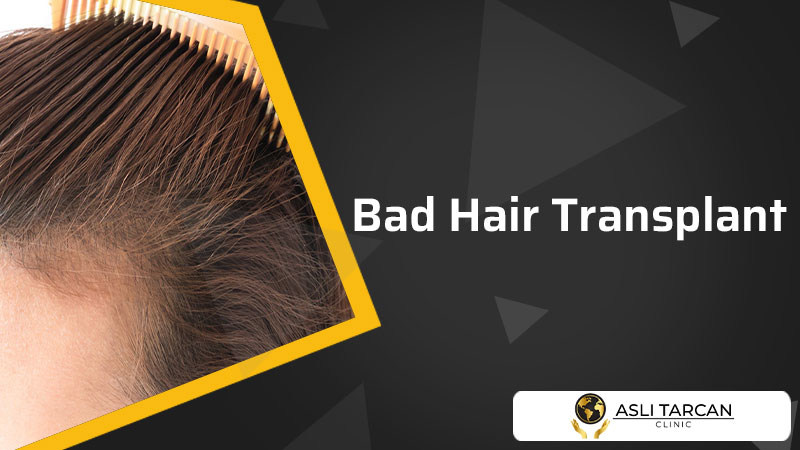Bad Hair Transplant
Bad hair transplant techniques result in a slew of issues that must be addressed. The original hair transplant surgery demands more ingenuity and skill than correcting a defective hair transplant. As a result, it’s critical to choose the facility and doctor where the application will be submitted from the start. Although hair transplantation costs vary, it should be emphasized that bad hair transplantation is far more expensive and takes much longer. Furthermore, a bad hair transplant might lead to far more serious issues than psychological hair loss.
For those considering a hair transplant, a bad hair transplant sounds like a nightmare. A hair transplant candidate might expect thick, natural-looking hair after the procedure. Many clinicians, however, are unaware of these expectations. The hair transplant candidate feels more confident when the transplanted hair mixes in with his or her natural hair. Unfortunately, many physicians do the procedure wrong. Many patients seek aid from other clinics after a failed hair transplant. What are the reasons for a hair transplant that doesn’t work? What’s the best method to deal with a hair transplant that doesn’t work?
It’s natural to feel concerned, especially before undergoing a cosmetic procedure such as a hair transplant. The joy that follows a successful hair transplant procedure, on the other hand, far exceeds expectations. If you’re thinking about getting an FUE hair transplant, you should learn more about the technique beforehand. Apart from knowing about possible difficulties, it is also beneficial to understand how to avoid them.
How To Define A Bad Hair Transplant?
A bad hair transplant might leave you with a number of unfavorable outcomes, such as visible or severe scarring, implant clusters, and uneven hairlines. During an FUE surgery, an untrained hair surgeon may over-harvest the same area of the scalp, leaving inadequate amounts of hair in the donor sites. During FUT, an excision in a conspicuous site may be done, leaving a visible scar, even if the surrounding hair grows back.
It might be difficult to achieve a natural-looking hairline, but it is essential for a successful hair replacement. Large grafts were used in previous hair transplant surgeries, which were known for their “pluggy” look and were plainly visible to even the untrained eye. You should expect nothing less than the finest from your hair transplant surgeon, since modern procedures may create absolutely natural results.
If you’re unhappy with the outcomes of a previous operation, seek treatment from a facility that specializes in corrective hair transplant surgery to update earlier transplants that don’t seem natural or to remedy flaws from a badly executed transplant. If you are interested in hair transplantation surgery but are concerned about having a substandard transplant make a little research. Make an appointment with many doctors and clinics to make up your mind to avoid bad hair transplantation possibilities.
What Makes A Hair Transplantation Bad?
FUE and FUT are the two most common graft extraction procedures. A bad operation is determined not just by the implants used, but also by the extraction chain used. During the pre-surgery evaluation, a doctor should identify and estimate the number of grafts to be transplanted. Everyone has their own donor capability. A few months following the procedure, too many grafts extracted from the poor donor location result in a horrible hair ook. In one square centimeter, about 20-25 percent of the grafts should be excised.
Keep in mind that not everyone is a good candidate for this operation. An evaluation performed before the hair transplant can quickly indicate whether or not a patient is appropriate. It is better to ask a patient about his expectations. Yet, it is not possible to do a dense transplant out of nothing. Surgeons should tell the patient the real capacity during the first consultation.
How To Fix A Bad Hair Transplant?
It’s worth noting that repairing a botched hair transplantation is more difficult than starting from scratch. It takes a great deal of work, expertise, and experience on the part of the operation doctor. Many patients seek treatment to correct a failed hair restoration, which is a difficult surgery. They are dissatisfied with their ‘grass man’ hair and are self-conscious about their look. Hair that seems fully natural may achieve with modern hair restoration procedures and treatments.
This is a difficult technique that necessitates prior experience. The procedure is the same as when hair roots extract from the rear of the head using the FUE method. Extraction can do in many sessions separate by 10-15 days. Only after all numerous roots pulled, divided, and re-transplanted on the frontal hairline does the bad appearance fade. Multiple grafts can separate and placed in the gaps once they’ve split. This method also conceals scars. Grafts extract using either a micromotor or a manual punch. It has to be somewhat larger than the many roots. It will be difficult to extricate grafts otherwise. If a transplant candidate does not want to create a hairline, these grafts can transplant one by one to their previous locations.
What Makes A Hair Transplantation Good?
The outcomes of healthy hair restoration should be indistinguishable from the surrounding hair. To put it another way, the untrained eye should not be able to tell you’ve had an operation. Healthy hair follicles may be able to effectively transplanted into any balding area of the scalp using the procedures of follicular unit transplantation (FUT) and follicular unit extraction (FUE). A skilled surgeon should also know how to put the transplanted follicular units in such a way that they will blend in with the existing hair.
FUT is a procedure that includes removing a strip of skin from the back and sides of the scalp to obtain healthy follicular units for transplantation to other parts of the scalp. This treatment leaves a scar where the excision suture closed, although scarring can minimize with good excision and advanced suturing techniques by a qualified and experienced expert. A tiny circular punch used to extract follicular units one by one during FUE operations is as important as the surgery. So that, this little punch is reducing the need to remove a strip of the scalp. Although this method does not require sutures, it might result in little circular scars where the follicular units collected. These scars, on the other hand, are little and almost invisible.
What is a Hair Transplant Infection and How Bad is It?
A hair transplant infection is a serious condition that can lead to permanent damage to the scalp and hair follicles. If left untreated, an infection can cause scarring, hair loss, and other complications which will negatively affect the results of a hair transplant. Before and after, most infections can be treated with antibiotics and anti-inflammatory medications, though some cases may require surgery to remove the infected area. Additionally, it is important to take all post-operative instructions given by your hair transplant doctor seriously and follow them closely to minimize your risk of developing a hair transplant infection. It is also recommended that patients adhere to a strict hygiene routine to avoid any potential infections after their procedure.

In any case, it is important that you seek prompt medical attention if you have signs of an infection or think that your transplant may be infected. Early diagnosis and treatment are key to minimizing the risk of any long-term complications associated with a hair transplant infection. With close monitoring from your doctor, you should be able to avoid serious consequences from a hair transplant infection.



